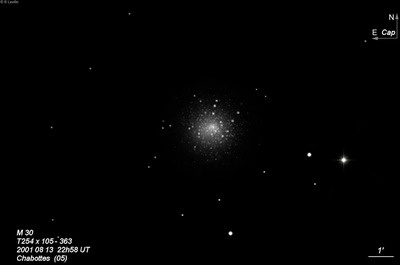
Charles Messier discovered M30 = NGC 7099 = h2128 = h3878 on 3 Aug 1764. WH first observed the globular on 31 Jul 1783 using his 12-inch (small 20-foot) and reported "Power 200; it consists of very small stars; with two rows of stars, 4 or 5 in a line." He later wrote, "It is a difficult step i.e. if we divide the transition from the Pleiades down to the Nebula in Orion into six steps, this perhaps the 4th towards the real nebulas. The stars in this seem to be of two different sizes for I perceive 3 or 4 very visible ones branching out towards the north and several more exceedingly small at the sides. Towards the south in one place the light is very intense, but has all the appearance of crowded stars; so that there remains no doubt of the whole being stars."
In PT 1814, WH summarized his observations of M30 as a "brilliant cluster, the stars of which are gradually more compressed in the middle. It is insulated, that is, none of the stars in the neighborhood are likely to be connected with it. Its diameter is from 2' 40" to 3' 30". Its figure is irregularly round. The stars about the centre are so much compressed as to appear to run together. Towards the north, are two rows of bright stars 4 or 5 in a line." He speculated in his 1814 publication that the "lines of bright stars, although by a drawing made at the time of observation, one of them seems to pass through the center, are probably not connected with it."
JH made the following detailed observation on 23 Sep 1830: "Fine cluster; irreg R, with two projections A, B, at its northern side. (See fig. 90.) A is directed from the central brightness and consists of 3 or 4 bright stars 12 m; its position taken with microm = 350.4°; B originates in the preceding side of the centre, and is directed in a position 331.7° in a line not passing the centre; diam = 6', stars = 12m; fine object; has a * 9 m preceding it (2 or 3 diameters by diagram)." From the Cape of Good Hope, he logged "Globular, B; lE; bM; 4' l, 3' br; all resolved into st 16m, besides a few 12m. Two lines of rather larger stars run out n[orth f[ollowing]."
200/250mm - 8" (10/4/80): two short straight star lanes to north and NW give a unique "prong" appearance. A few faint stars are resolved southeast of the core but the core is unresolved.
300/350mm - 13.1" (9/29/84): fascinating view at 350x; ~25 stars resolved in the outer halo. A few stars (half dozen) are bunched together near the bright, unresolved irregular core over a fainter diffuse halo.
13.1" three star lanes are obvious on the north side. Good resolution in the halo and outer stragglers. The core appears on the verge of resolution at 288x.
400/500mm - 17.5" (8/17/01): viewed at 575x in excellent seeing. Very irregular appearance with strings of stars emanating from an irregular bright, partially resolved core. A prong off the west side heads northwest and includes three equally spaced similar stars along with a close triple. Another bright line of three stars heads due north with a fainter bent elbow of stars angling towards the NE. Roughly a dozen stars trail to the east with a large gap towards the edge of the halo. A fairly well defined semi-circle of stars open to the north passes directly through the core and off the SE side. The outer halo is peppered with dozens of faint stars over a dim background haze and with concentration the overall diameter increases significantly to at least 10'.
17.5" (7/5/86): the small bright core was not resolved but the halo was well resolved into 50-60 stars. A small circular detached piece is east of the core with resolved stars. Along the north side the resolved stars are brighter and arranged in lanes.
900/1200mm - 48" (10/27/19 and 10/24/14): at 375x; several hundred stars were resolved right down to a small brighter nucleus. Several very bright stars were in chains that emanated from the core. The halo seemed fully resolved with a very large range in magnitudes. The outer halo was scraggly and contained some bright stars, but overall the halo was fairly symmetric.
The first of three bright stars in a string directly to the north of the core (~40" N of center) was clearly orange (red-giant) as well as the first of a string of three bright stars starting at the west edge of the core (~55" W of center) extending northwest. A few other brighter stars either appear yellow or very pale orange!
Notes by Steve Gottlieb